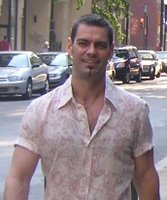Heartbreaking
Ensign Melquisedet Angulo Córdova, a Special Forces sailor killed last week during the government’s most successful raid on a top drug lord in years, received a stirring, national tribute in which the secretary of the navy presented his mother with the flag that covered her son’s casket.Last summer I read Charles Bowden's "The Sicario: A Juárez hit man speaks" (Harper's Magazine, May 2009, subscription required). It's a shocking interview with a former hit man for one of the Mexican drug cartels. I was profoundly affected by it, and even now, scanning the article for an excerpt to include here, I have the chills. (Warning: The following contains graphic depictions of torture.)Then, the next day, only hours after the grieving family had finished burying him in his hometown, gunmen burst into the family’s house and sprayed the rooms with gunfire, killing his mother and three other relatives, officials said Tuesday.
He especially wants to know what I know about the two death houses uncovered last winter. I say one had nine bodies, the other thirty-six.I've avoided writing anything about this article, though I've discussed it with some friends. I didn't want to sound like I was moralizing. But after reading the article about that Mexican sailor's murdered mother, I felt compelled to write this: Americans have to wake up and face their responsibility for what's happening south of our borders. America provides the demand; Mexico offers the supply. Clearly the sicarios and their bosses bear the burden for the lives that are taken. But we in the U.S. have to face the fact that their motive is profit, and we are the customer. We are complicit in these deaths.
No, no, he insists, the second one had thirty-eight, two of them women.
He carefully draws me the layout of his second death house. One of the women, he notes, was killed for speaking too much. The other was a mistake. These do happen, though the bosses never admit to it.
But he keeps returning to the death house with the thirty-eight bodies. It has memories for him.
I remember standing on the quiet dirt street as the authorities made a show of digging up the dead. Half a mile away was a hospital where some machine-gunned people were taken that spring, but the killers followed and killed them in the emergency room. Shot their kinfolk in the waiting room also.
“The narcos,” he wants me to understand, “have informants in the DEA and the FBI. They work until they are useless. Then they are killed.”
As for those who inform to the FBI and DEA, they “die ugly.”
He explains.
“They were brought handcuffed behind the back to the death house where they found thirty-six bodies,” he rolls on. “A T-shirt was soaked with gasoline and put on their backs, lit, and then after a while pulled from their backs. The skin came off with it. Both men made sounds like cattle being killed. They were injected with a drug so they would not lose consciousness. Then they put alcohol on their testicles and lit them. They jumped so high—they were handcuffed and still I never saw people jump so high.”
Another excerpt from Bowden's article here. And Democracy Now interviewed Bowden last August; it begins at the 28:30 mark.
Labels: video





1 Comments:
This is a difficult post. Terribly hard to read. I agree that some Americans can be seen as complicit in these deaths. What would you offer as a strategy for the rest of us, to face our responsibility to what's happening there....and to what degree do you see us as responsible?
Perhaps simply by beginning to expose this issue, as you are doing, is a positive step.
Post a Comment
<< Home